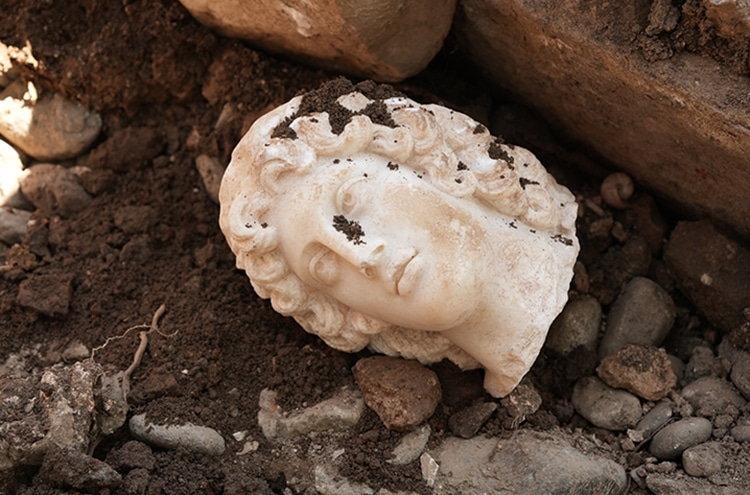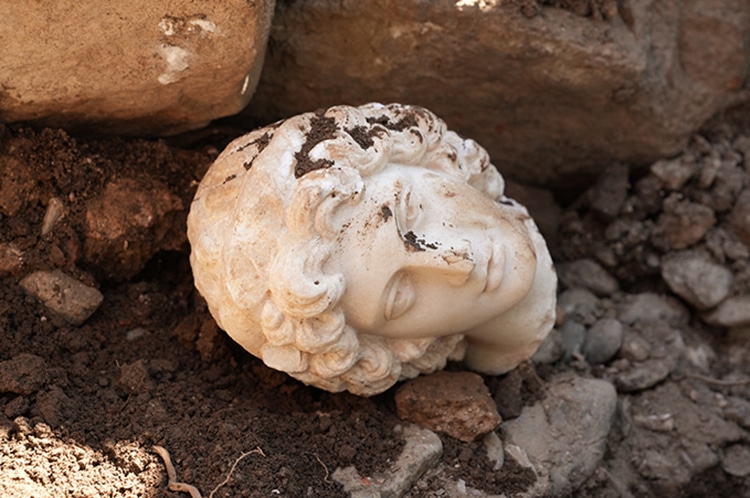
Photo: Düzce Municipality
Ancient leaders such as Caesar and Nero have become figures of popular myth as well as history in the centuries since their reigns. This process of transforming a political leader into an idea began quite early for some, such as Alexander the Great. The Macedonian military leader ruled all of Greece and as far eastward as Pakistan and Afghanistan. His death in 323 BCE divided his empire among his generals, but it also enshrined the deceased in Greek—later Roman—legend. This enduring fascination is evidenced by a recent find of a second-century marble head depicting Alexander at the site of a Roman theater in Turkey.
The marble head, decapitated from its former body, was discovered in the remains of the upper levels of a Roman theater at Konuralp, north of Düzce, Turkey. Part of the Roman Empire, it has once been Alexander the Great’s territory. However, the statue was created in the second century CE, over 400 years after the leader’s death. Despite this temporal gap, archeologists were able to recognize it by the distinctive posture and hairstyle. Firstly, his eyes are lifted to heaven, a typical glance seen in depictions of Alexander. Additionally, the elegantly carved voluminous hair of the statue is iconically Alexander. “The two tufts of hair in the middle of the forehead, which are separated to the back and sides, are like a lion’s mane,” reads a statement from Düzce. “This depiction is a hairstyle unique to Alexander the Great.” Also, Alexander was famous for preferring a clean-shaven look.
So why would the Roman-era inhabitants of Turkey immortalize Alexander the Great so long after his death, carved alongside gods and other figures in marble? Alexander had in fact become something of a mythical historical figure, invoked by interested parties to idealize leadership. His rapid conquering of vast swaths of land, his tutelage under Aristotle, and his young death set him up as a reference point, even once much of the Hellenistic Macedonian empire he ruled came under later Roman control.
Alexander’s likeness on coins and in marble could serve as a legitimizing force, and a symbol to an idealized Hellenistic culture. As out of place as his discovery in a Roman-era theater in Turkey might seem at first glance, it is emblematic of the continuing cultural and military legacy of the Macedonian king.
Alexander the Great achieved an almost mythical status in the centuries after his death, as evidence by this Roman statue from the second century CE.

The head of an Alexander the Great statue found in Konuralp, in northwest Turkey near the city of Düzce. (Photo: Düzce Municipality)
Alexander conquered a vast swath of land stretching east to Afghanistan.

Another more contemporary depiction of Alexander on a sarcophagus. (Photo: Ronald Slabke via Wikimedia Commons, CC BY-SA 3.0 DEED)
h/t: [Live Science]
Related Articles:
Herculaneum: Pompeii’s Sister City That Survived a Volcanic Eruption in Ancient Rome
1,600-Year-Old Ancient Egyptian Socks Look Like Modern Fashion Statements
5,000-Year-Old Iranian Vase Features the First Known Animation
Explore the Early 20-Side Icosahedron Dice That Were Tossed in Ancient Rome
